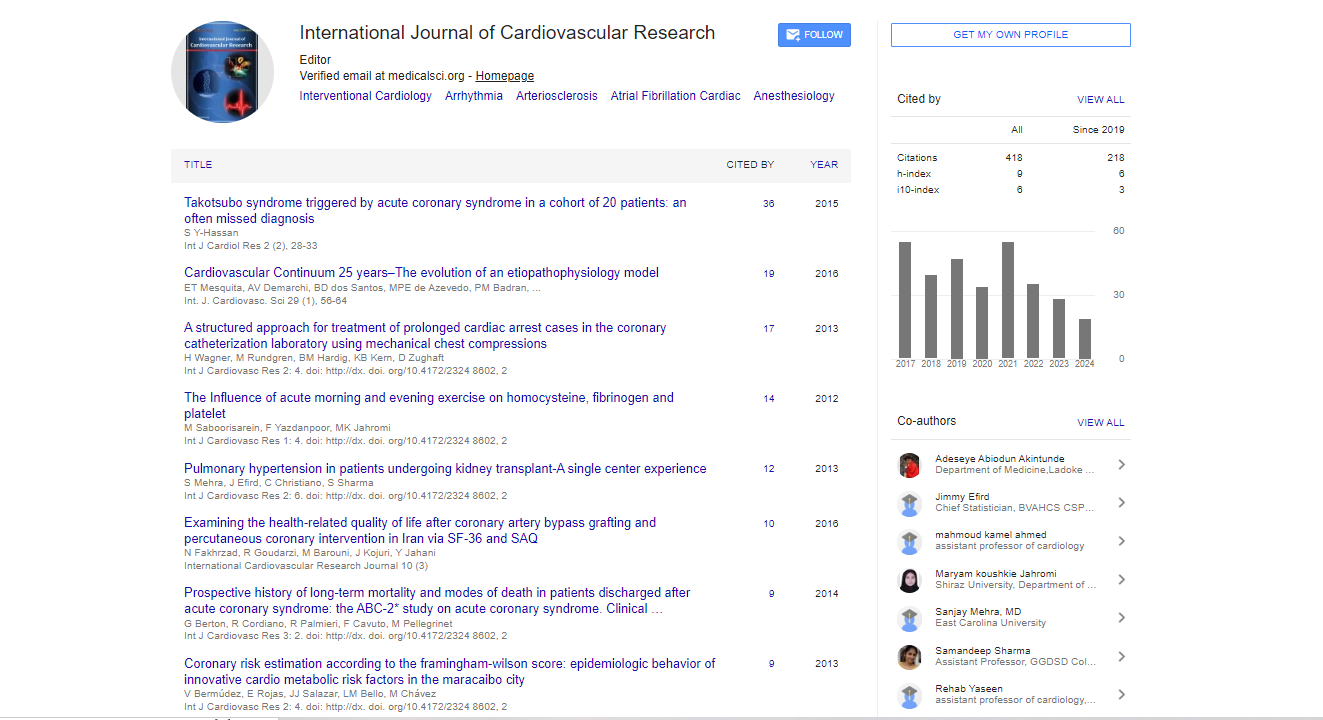Commentary, Int J Cardiol Res Vol: 13 Issue: 6
Utilising Echocardiography to Determine the Proximal Aortic Diameter (Echocardiogram)
Alistair Ravenscroft*
Department of Biomedical Data Science, Stanford University, Stanford, California, USA
- *Corresponding Author:
- Alistair Ravenscroft
Department of Biomedical Data Science,
Stanford University,
Stanford,
California,
USA;
E-mail: alastair.ravenscroft@gmail.com
Received date: 07 November, 2023, Manuscript No. ICRJ-23-119415;
Editor assigned date: 09 November, 2023, PreQC No. ICRJ-23-119415 (PQ);
Reviewed date: 23 November, 2023, QC No. ICRJ-23-119415;
Revised date: 16 December, 2024, Manuscript No. ICRJ-23-119415 (R);
Published date: 23 December, 2024, DOI: 10.4172/2324-8602.1000594
Citation: Ravenscroft A (2024) Utilising Echocardiography to Determine the Proximal Aortic Diameter (Echocardiogram). Int J Cardiol Res 13:6.
Description
Echocardiography, a non-invasive and readily available imaging technique, has become an invaluable tool in assessing cardiac anatomy and function. Among its many applications, echocardiography plays a vital role in determining the proximal aortic diameter. Accurate measurement of the proximal aortic diameter is essential for diagnosing and monitoring aortic pathology, including aneurysms, dissections, and other cardiovascular conditions.
Understanding the proximal aorta
The proximal aorta, also known as the ascending aorta, is the initial segment of the aorta originating from the left ventricle of the heart. It plays a vital role in pumping oxygenated blood to the entire body, making it an essential component of the circulatory system. The health and dimensions of the proximal aorta are vital indicators of cardiovascular well-being.
Significance of proximal aortic diameter
An aortic aneurysm is an abnormal bulging or dilation of the aorta. Aneurysms can occur in various segments of the aorta, and the proximal aorta is a common location. The measurement of the proximal aortic diameter helps in the early detection of aneurysms, which can be life-threatening if left untreated. Accurate measurement of the proximal aortic diameter aids in assessing an individual's risk of developing aortic pathology. It is a valuable tool for risk stratification and guiding clinical decisions. The management of aortic pathology often involves surgical intervention. Determining the proximal aortic diameter is important in deciding when surgical repair is necessary. Aortic surgery may be indicated if the proximal aortic diameter exceeds a certain threshold, depending on clinical guidelines.
Echocardiography for proximal aortic diameter measurement
Echocardiography is a non-invasive imaging modality that uses high-frequency sound waves (ultrasound) to build real-time images of the heart and surrounding structures. It is particularly useful in assessing the proximal aortic diameter due to its advantages:
• Echocardiography does not require the insertion of catheters or
exposure to ionizing radiation, making it safe and well-tolerated by
patients.
• Echocardiography provides real-time images of the heart and aorta,
allowing clinicians to visualize dynamic changes and assess the
structure and function of the aorta during the cardiac cycle.
• Modern echocardiography machines offer high spatial resolution,
enabling accurate measurement of the proximal aortic diameter.
• Echocardiography can be complemented with other imaging
modalities such as Doppler echocardiography, allowing for
simultaneous assessment of blood flow in the aorta and valve
function.
Measurement techniques
Two-Dimensional (2D) echocardiography and M-mode echocardiography are commonly used to measure the proximal aortic diameter. The following techniques and views are employed:
• Parasternal long-axis view, in this view, the aorta is visualized from
the left parasternal location. The proximal aortic diameter is
measured perpendicular to the long axis of the aorta, usually at the
level of the aortic valve.
• The aortic root diameter is often measured at the sinuses of
Valsalva, where the aortic valve cusps attach to the aorta. This
measurement is essential for assessing the risk of aortic valve
disease and aortic aneurysms.
• A transverse image of the aorta can be obtained by slightly angling
the transducer in the left parasternal location. In this view, the aortic
diameter is measured perpendicular to the vessel's long axis.
Clinical application
Echocardiography is widely used in clinical practice to assess the proximal aortic diameter for various purposes.
Patients at risk for aortic aneurysms, including those with a family history, connective tissue disorders, or risk factors such as hypertension, are screened using echocardiography. Serial measurements help monitor aneurysm growth and determine when surgical intervention is necessary. Echocardiography is vital before aortic valve surgery or other cardiac procedures. It provides vital information on aortic root dimensions, which can impact the choice of prosthetic valves and surgical techniques. Patients with known aortic pathology, such as Marfan syndrome, bicuspid aortic valve, or previous aortic surgery, undergo regular echocardiographic assessments to monitor the proximal aortic diameter for disease progression.
Conclusion
Echocardiography is a powerful and non-invasive imaging modality used to assess the proximal aortic diameter. Accurate measurement of the proximal aortic diameter is essential for the early detection of aortic pathology, risk assessment, and clinical decision-making. Echocardiography is a valuable tool in clinical practice, aiding in the prevention, diagnosis, and management of aortic aneurysms, dissections, and other cardiovascular conditions. As technology continues to advance, echocardiography will play an increasingly important role in improving patient outcomes and enhancing our understanding of cardiovascular health.
 Spanish
Spanish  Chinese
Chinese  Russian
Russian  German
German  French
French  Japanese
Japanese  Portuguese
Portuguese  Hindi
Hindi 



